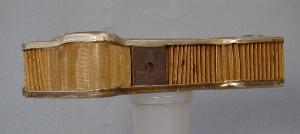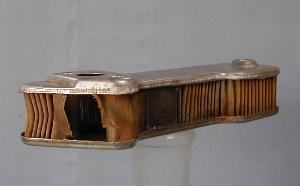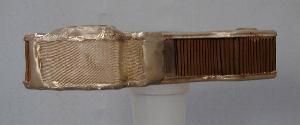|
|
|
![]()
A quick look at the picture below shows an original filter fresh from the packet and still covered in its protective oil. The dark grey areas are the magnets and the brass pleated screen is clearly evident. The whole thing is very neatly spot-welded together across some steel tubing supports and the brass screen is glued to the steel with what appears to be an epoxy adhesive. See, I told you it was leading edge stuff for a late 1960's design……Cue corporate comment from declining British bike company .."Glue in a bike engine? They'll put a man on the moon next. What, they already have ?".

The original and new filter.
Anyway, back to the plot. Tony Hall of Halco Tuning commented that back in his
moto-cross days it was quite common to reinforce the sump filter with a piece
of mesh and something like Araldite. At the Brands Hatch Festival of a Thousand
Bikes one year I was talking (no surprise there) to a guy running an XS650 engine
in a racing outfit. He pretty much reiterated what I had so far learnt i.e.
all XS650 filters split, it's just a case of when, not if. The racer, like me,
couldn't countenance using the engine without the sump filter so he had "armoured"
his with steel mesh and bailing wire from a local farmer!
Two further possible remedies have been used in the past. One is to use low
viscosity, modern, synthetic motor oils and this certainly seems to extend the
filter life. The down side is that all the tolerances in the engine were set
up for good old-fashioned 20/50. Unless you have the engine rebuilt at the same
time and insist on tighter rebore, piston and ring clearances the engine will
smoke like a good 'un. Similarly the valve guides would need to be machined
to tighter tolerances. The other option (as seen on several US websites) is
to weld/solder a piece of tin can over the offending area. I suppose this must
work but it does mean that part of filter is then obscured and this could put
more strain on the rest of the mesh.
The brass screen is pleated over its entire length with the exception of two specific areas. The pleating serves two purposes; firstly to increase the surface area of available filtration and secondly to act a shock absorbing device for the flow of oil through the screen as the pump sucks. So why on God's good earth did Yamaha leave two pieces of straight, unpleated, brass mesh at the oil pick-up point? Because they bloody well could, that's why!!!! The generally acknowledged reason for the splitting filters seems to be that the flow of cold 20/50 on the unpleated area is more than the mesh can withstand, so suck, suck, suck goes the pump, pop goes the filter, "oh! my word" go you and I, and kerr-ching go Mr. Yamaha's cash register. The picture below will be horribly familiar to any XS650 owner out there.

Broken, but not beyond repair.
Hang on folks, I may have something of real value to say soon. We'll have no
heckling from the East Anglian stink wheels contingent or XS Owners Oop North
either, thank you very much! My parsimonious nature finally got the better of
me so off I went, with a selection of filters, to work. You know the place;
it's the one where you go Monday to Friday so that you can get all the jobs
done you didn't finish at the weekend.
I have, at work, a really clever soldering iron (and I'm not afraid to use it). It's able to sense how much heat a "widget" needs as you solder so it never over or under heats things. I've also got some soldering fluxes that truly are the "puppies privates". Add these two together with some stainless steel mesh and you have the beginnings of a skinflint's idea of heaven. Moderately damaged screens are eminently repairable, other wise I have worked on new filters with a view to extending their normal 1500-mile service life. With the stainless steel mesh soldered over the weak spots the ends can be attached to the brass mesh again using solder and stainless steel specific flux. The magnetic part of the filter did cause a few moments of concern, as it's not solderable! In a moment of "Worzel Gummage" head swapping it was off with the soldering head and on with the glue head! Friends in the trade, or the know, can be so useful. A quick splat of industrial, steel filled, two-part epoxy and "it was as right as rain Mr. Crowman, Sir!" The picture below shows a typical strengthening repair. It may not be particularly pretty but then again neither are bailing wire or welded baked bean cans! I can hear the cynics out there casting aspersions, oh ye of little faith. I've run for 4500 miles with a filter thus modified and our beloved editor has also been using the Mk2 Raffles patented filter system……..and he's been round the planet at least twice on his XS650.

The repaired article
My knowledge of bikes is, I readily admit, limited to Japanese two strokes,
XS650's and MZs. However, if anyone has a similar persistent problem with the
built in obsolesce of any sort of filter please give me a call (01582-613-997)
and I'll do whatever I can to help.
Steve